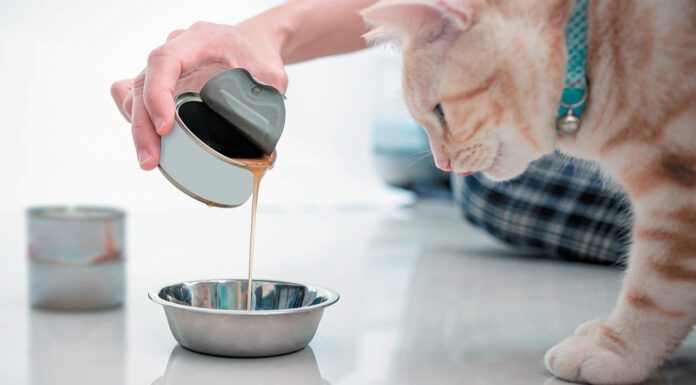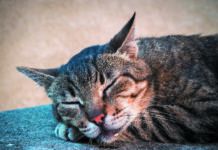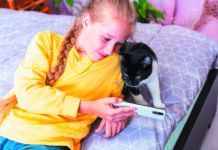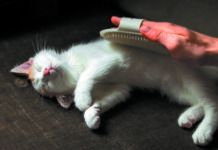Are you aware of the Food and Drug Administration’s pet food hygiene guidelines for minimizing the spread of harmful bacteria in your home that can make you or your cat sick? If not, you’re by no means alone. When researchers asked pretty much the same question of more than 400 people participating in a study about pet food handling and pet food bowl hygiene, less than 5 percent of them knew such guidelines existed.
It’s particularly concerning in light of the fact that 36 percent of the households surveyed had children younger than 13 or immunocompromised family members — or both. Those two groups of people have immune systems that might not be as good as those of healthy adults at vanquishing harmful bacteria that could make them sick. The study was conducted on owners of dogs, but the same lack of knowledge no doubt applies to many cat owners as well.
How big a problem is subpar hygiene when it comes to pets’ food and water bowls? Previous research that looked at 32 household surfaces showed that pet food dishes had the ninth highest level of contamination with bacteria. Another study indicated that the surfaces of pet food bowls have higher bacterial loads than toilets.
But do proper handling and washing really help?
To see if properly handling pet food and washing food and water bowls can really cut down on bacterial counts, the researchers swabbed pet bowls for bacteria in 50 households, then divided those households into three groups for one week. One group was supposed to just keep doing whatever they did to feed their pets. Another was asked to institute FDA guidelines to keep pet food bowls clean. The third group was put to an even more stringent test; they were asked to follow the government’s guidelines for handling food meant for people as well as pets.
The results? A second swab for bacteria after the week went by showed that those following either set of official guidelines had a bacterial reduction in the range of 90 to 99 percent. Those who did what they always did had no reduction in bacterial counts on their pets’ bowls.
So what should people
be doing?
The FDA’s tips for preparing pet food are not complicated. The main ones:
Begin and end with clean hands. Both before and after handling pet food and treats, wash your hands for at least 20 seconds with soap and hot water.
Wash pet food bowls and scooping utensils with soap and hot water after each use. [Italics ours.]
Do not use your pet’s food bowl as a scoop. Use a clean scoop, spoon, or cup instead. Use the scooping utensil only for scooping pet food.
It’s certainly all logical, even intuitive, yet the study, published in the journal Plos One, found that fewer than 25 percent of the people surveyed routinely washed their hands as recommended prior to handling pet food. They also did not wash pet food dishes or the scoop according to recommendations after each use. One in five respondents reported washing their pet’s food dish only once weekly, on average. Many said they washed the dish less than every 3 months — or not at all.
Furthermore, when respondents did wash the food bowls, they often did it with soap and warm water, not hot, as recommended. Some just rinsed with water and didn’t use any soap whatsoever.
Now that you know…
Unfortunately, after the one-week experiment, only 8 percent of participants who had been instructed to follow the protocols for clean pet dishes said they were likely to adhere to the recommendations long-term. Don’t be complacent. Now that you know the simple guidelines for keeping your pet’s bowls clean and thereby minimizing the presence of bacteria that could make you or your cat sick, make pet dish hygiene a habit.





Glad to read I am not as anal about clean food dishes as I thought. 😹 The water in my building is scalding hot so the stuck on wet food comes off easily after soaking them in the hot soapy water. To not contaminate my kitchen sponge, I use a wet paper towel to scrub the bowls of the dried on wet food. Toss paper towel when done.
My 4 cats eat wet food twice a day and dry food is out 24/7. If the dry food bowls are not empty each morning and if it’s more than just crumbs which I would put in the trash, I pour what’s left in a ‘holding’ bowl, thoroughly wash and dry the dry bowls, put fresh dry food on the bottom and put the “leftovers” on top.
Water bowls and fountains also have bacteria from “cat slime”. Daily scrub water bowls, clean fountains including the motor housing every 7 to 14 days. Lots of bacteria lurks in fountain motors.
Wash placemats often, too!
All of my cats have lived from 17 to 22 years old. I think I must be doing something right. 😻
I do try to do my due diligence when cleaning our guy’s bowls. His wet food dish gets washed after each meal (2x day) and his dry bowl I will be cleaning daily from now on. He’s on a timed feeding so no food sits, but the bowl still gets dirty. He has two fountains and since the bowl is white, you can see the slime and cat hair easily. I agree….every 10-14 days for cleaning them works the best for us.
Cat box hygiene is important too! Obviously (hopefully) wash hands after handing the box, but on a regular basis we dump both, scrub with hot water/soap/bleach/ and let sit in the sun for a few hours to dry. If your cat gets a bit anxious like ours, do one box at a time.
We too have been blessed with long lived cats – we lost Dean’s brother last year at age 10. Not from anything discussed here, but from HCM.